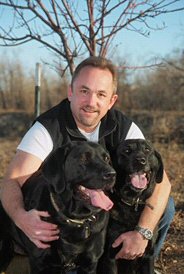 Part 1 : Presence
Part 1 : Presence
 Part 1 : Presence
Part 1 : Presence
I was a complete basket case when my beloved Black Labrador, Beezer, was diagnosed with early stage kidney disease. The disease ultimately took his life on May 1, 2005 at age nine. Looking back, so much of that journey during his illness was consumed by FEAR. My fear for my dog, my fear for the journey, my fear for my own life after Beezer passed. It was a numbing to the bone kind of fear attendant to massive uninvited life changes. I progressively grew more depressed and unable to complete even simple day-to-day tasks. I spent my time in search of better doctors and better treatments, but most of all, I spent virtually every waking hour in paralyzing fear.
Beezer became my teacher during this time. He and I came to explore the nature of fear and soon developed strategies to cope with this emotion. Beezer never got better, but we learned how to enjoy each day together. I refined these lessons when his brother, Boomer, contracted bone cancer just over a year later. Looking back, my Journey with my trusty Labs was a grand success. Our relationship was never better than the time during their illnesses. Beezer and Boomer taught me how to not be afraid.
I realized that my two biggest problems were deeply ingrained with my concept of time — past, present and future. I would second guess and relive past decisions under the various headings of “Why didn’t I try this before,” ”If only _____,” and, my personal favorite, “It’s my fault because _____.” These episodes were simply my ego talking to me. My ego was infecting me with guilt over something that happened before. I decided that to feel guilty is nothing more than to live in the past.
Moreover, to live in fear is to live in the future. In the beginning, the dogs would watch in silent amazement as I rushed about obsessing over things that hadn’t even happened. “How much time do we have?” “What if this happens in a week?” The problem with this thinking was that my fixation over the future caused me to ignore today. The key, I decided, was to avoid living in both the past and the future. I called this presence.
Presence is simply living in the moment. This proved to be a bit easier said than done.
Part 2 : To Fear is to Fuel
I began to think about the goal of a fatal disease. What did it want? Was I an accomplice, a victim, a witness? It had to be something. The easy response was “The disease wants to kill Beezer.” However, is that really the goal?
I certainly understand that I will die someday from something. I also understood that Beezer would die someday from something. If so, then what does the fatal disease bring to the table that wasn’t there yesterday? It cannot be death, because I understand that if you are born, you die. It is our contract from birth.
My answer was that the disease wanted me to give up today (the here and now). It’s just that simple. The goal of a fatal disease is to get me to give up today. The disease accomplishes that goal through the infection of fear into me.
Today should be so very special because of the disease. I should cherish today as never before. Did I? Of course not. I was too busy living in fear of the future. A future that didn’t exist today. A mirage in my mind. That was the goal of the disease. To plant the mirage and convince me to live in the future.
Now the sneaky part of the disease is that it couldn’t rob me of today. It couldn’t take today away from me over my objection. It wasn’t that powerful. No, the disease had to trick me into giving up today. I would have this wonderful precious asset in my hands, today, and simply hand it over on a silver platter to the embezzler of today, the disease. I’d forfeit today to the con man, as if to say, “Here, you take today, I don’t want it. I can’t deal with today.” Imagine that.
I realized my fear of the disease was the fuel that was being used against me. Devilishly clever, my biggest enemy was not the disease, but ME!. I was the power source being used to generate the very negative energy destroying my own being and wasting a special day with my beloved dog.
This paradox was glaring. I had thought the growing presence of disease was causing my mounting fear. In fact, just the opposite was occurring. My daily increasing fear was causing the disease to grow and become more powerful. I decided it was high time to start working for me and the Beez, not against us.
Part 3 : The Power of Meaning
Ever been stuck in traffic? Three lanes and nobody moving? I looked around once and was puzzled by what I saw. One person was laying on the horn, mouthing single syllable sentences punctuated by decisive gestures. One car over, another person was quietly singing a song of apparent significance. Both persons had the same incoming message -- stopped traffic -- but both persons attached a completely different meaning to the message. I wondered if I could apply that to my situation with Beezer?
I decided that incoming messages are neutral. That is, an incoming message means absolutely nothing until the listener attaches a meaning. Up to now, I’d been attaching fear as the meaning to every incoming message concerning Beezer. I decided to create different meanings to these same incoming messages.
I already knew the past (guilt) and the future (fear) were dangerous places for me. My strategy would be to create mechanisms and meanings which would keep me present. My safe zone was today. Whatever meaning I attached to the diseases had to allow me to remain present. I would starve the diseases of fuel because they cannot live in the present. I created three strategies.
Strategy #1 : Permanent Time-Out
The disease was part of our lives. I couldn’t change that. I couldn’t pretend the illness wasn’t here. I had to deal with it, but I needed a way to relate to the disease on terms I could understand. I decided to give the disease a character.
I found an old “kiddie chair.” I wrote “Kidney Disease Time Out Chair” on a piece of paper and glued it to the chair. I then placed the chair in a prominent place in my house. I then invited the disease to stay, but informed the disease that there were going to be several rules:
1. The disease could never again speak to me again without my permission. The disease could hold up signs like “Can I scare you today?” but planting words in my head was out.
2. The disease could stay in our lives as long as it wanted, but it was restricted to the permanent time-out chair. We were busy enjoying today and would try to make time for the disease later. So just sit tight and we’ll get back to you.
3. The disease had to wear pink fuzzy slippers. Nothing on this planet is scary when sitting on a kiddie chair wearing pink fuzzy slippers. They play their games, I play mine.
I found the strategy helpful. The fact that the chair was out in the open was especially powerful because it reinforced my ability to control fear on a daily basis. Once, when feeling a bit scared, I composed myself and announced in a stern voice: “WHO SAID YOU COULD LEAVE THE TIME-OUT CHAIR?” It worked. I giggled and went back to my dog.
Strategy #2 : The Daily Point
Later on, Boomer helped me develop a game to deal with fear. As guys, we relish games where scores are kept and winners and losers determined. We created a game called the Daily Point. Here’s how it worked.
Every day, one single point was up for grabs. Either Boomer and I would get the point or Team Fear (now with a second kiddie chair) would get the point. One day, one point. There weren’t ties and we never had overtime. We had much fun every day with this game.
Each day we’d awake and Boomer and I would discuss how we were going to win today’s point. Nothing else mattered. Even on the bad days, we’d stubbornly refuse to give in to fear for the simple reason that we didn’t want to lose today’s point. We became obsessed with enjoying today and never looking further than how to win “the point.”
Strategy #3 : The Daily Appreciation
As Beezer grew more ill, I’d speak with him and give him my permission and blessing if he wanted to transition on his own. I didn’t want him pushing beyond his time because of my selfish need to hang on. We started having these talks at night just before bedtime.
I also realized that Beezer might prefer to pass on his own, out of my presence. Of course, that could mean I might come home one day and find that my buddy had left. I decided we needed to talk about that as well. I didn’t want any unfinished business or regret after it was too late to say a bit more.
We’d all gather on the bed and have a nightly discussion. Each exchange was different, yet the same. I’d start with telling each dog how much they meant to me and how lucky I was to have them in my life. I always thanked them for being in my life today. Sometimes we’d talk about fun times. Sometimes we’d talk about the difficult times. I’d explain the illness and my inability to change the outcome. I’d ask for input on how to spend what time we had left together. Above all, we always ended on a positive note by expressing our mutual love and deep appreciation for each other. I’d then immediately turn out the lights. I found these discussions of great comfort and continued them with Boomer after Beezer passed and later with my new Lab, Coral. It has become our nightly ritual.
My Hope For You
Of course, each journey is unique to the human and the animal. You should follow your instinct and always do what you think is best. What worked for me is nothing more than what worked for me.
I believe that everything happens for a reason and that reason helps me grow. I’m a much better person for the lessons taught by these two black dogs and am so deeply appreciative of our time on earth together. The B Brothers taught me to overcome fear and guilt. Along the way, I realized the abundance of love I showered on my dogs was the same love I withheld from myself.
In retrospect, I found my journey with my B Brothers was never about the body, it was always about the soul. I believe my Labs were sent to earth to teach me lessons I’d never have learned from any other teacher. In this way, our Journey with kidney disease and bone cancer was the most remarkable success story I’ve ever been involved with. A wonderful paradox that I would have missed entirely if I succumbed to fear.
Please be kind to yourself and enjoy today with your pet. You’ll treasure this most special time for the rest of your life.
© Doug Koktavy
Doug & the B
Brothers
From my upcoming book on overcoming fear and guilt when canine kids
get sick.
Visit www.DougandtheBBrothers.com for more
information.
July 7, 2007
In the previous article, Doug Koktavy shared his insight on coping when a cherished animal companion contracts a catastrophic disease. All too often, such diseases result in the death of a beloved pet, leaving the owner to suffer unbearable guilt. We are pleased and privileged to be able to share with you a list of reasons
not to feel guilty, as compiled and sent back to earth by Doug’s Black Labrador Retriever, Beezer.
BEEZER’S TOP TEN REASONS NOT TO
FEEL GUILTY
(Compiled
by Beezer, the Black Lab from the Bridge,
and sent back to
earth)
| 10. | Jeez! If you’re born, you die. Think about it dad. |
| 9. | Fear is the real enemy, not kidney disease. Fear is curable. I’m with you right now, just invisible. I’ll be waiting at the Bridge when you arrive. Don’t be afraid. Trust me. |
| 8. | Live with balance. The list of what went “right” with my life is so much bigger than the list of what went “wrong.” My body died from kidney disease, but my spirit always soared because of you. |
| 7. | What you focus on expands. Honor my earthly life and memory. Does feeling guilty help you remember all our good times, adventures and mutual love? |
| 6. | Live with Presence! Don’t despair about yesterday. Don’t fear tomorrow. Otherwise, you’ll miss out on the Gift of Today. |
| 5. | Thank you for taking my pain into your heart on that last day. I’m so proud of you for that selfless act. |
| 4. | Didn’t you always forgive me when I made a mistake? I forgive you for any mistake you made during my illness. You made the best decisions possible with the information available at that time. All I took with me on my final earthly journey was our love. Please accept my forgiveness and release the guilt. |
| 3. | Pat yourself on the back in between crying. Your effort to treat me was a supreme act of humanity, love and compassion. Our relationship was never more meaningful than during my illness. Please recognize your character and commitment. I do. |
| 2. | Guilt is what you humans do to punish yourself for not being perfect. |
| 1. | You didn’t have a cure for a fatal disease. My body stopped working because of this fatal disease, not because of something you did or did not do. |
|
© Doug Koktavy (May 1, 2005)
|
Selecting a Good Dog
Trainer/Behaviorist by Candice O'Connell
![]()
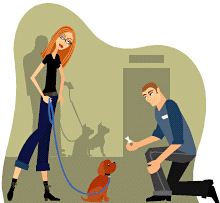 For most professional fields, there is usually a governing body that awards accreditation.
Not so in the
field of dog trainers and behaviorists.
So where does a
dog owner begin when looking for the right trainer or behaviorist?
For most professional fields, there is usually a governing body that awards accreditation.
Not so in the
field of dog trainers and behaviorists.
So where does a
dog owner begin when looking for the right trainer or behaviorist?
Selecting a good trainer or behaviorist is akin to choosing a personal fitness trainer for you. You want someone who has good communication skills, someone who uses tools and training techniques that you are comfortable with, and you would like someone who motivates you. Ultimately, you want someone who will help you achieve the end-result you are seeking, e.g. a well-trained dog with good social skills.
As difficult as it might seem to find
the right professional, there are some simple guidelines that may help you
select a trainer or behaviorist and a training technique that is best suited to
you and your canine companion.
A skilled and competent instructor will:
Every person and every dog is unique and so it may take a little effort to find the right trainer. You will know you have the right trainer if you are comfortable with the training tools and methods used. An experienced trainer employs humane training methods which are not harmful to the dog and/or handler. We do not recommend any trainer that advocates the practices of hanging, beating, kicking, shocking or similar procedures/devices that could cause the dog pain or distress or have the potential to cause physical injury. Remember that you, as the dog owner, have the absolute right to stop any trainer or other animal care professional that, in your opinion, is causing your dog undue harm or distress.
A conscientious trainer stays informed about innovations in dog training and behavior modification. It is always a good idea to check the trainer’s affiliation to any educational organizations such as the Canadian Association of Professional Pet Dog Trainers, Association of Pet Dog Trainers, and/or Professional Animal Behavior Associates, Inc. Ask if he/she pursues ongoing educational opportunities.
A good instructor will take care to protect your dog’s health in a classroom or group setting. Ask if dogs and puppies are required to be vaccinated prior to class and, if so, which vaccines are mandatory. Make sure you and your veterinarian are comfortable with the vaccination requirements. If not, ask if titers (*) are acceptable.
Current clients are a valuable source of information for you. Attending a group class gives you the opportunity to ask clients how they feel about their experience, i.e. are they enjoying the class and are their training needs and goals being met.
Because of variables in dog breeding/temperament and owner commitment/experience, a trainer cannot and should not guarantee the results of his/her training. However, an instructor should be willing to ensure client satisfaction with his/her professional services.
Finally, training your dog is an important part of being a responsible owner/guardian. It will help you to understand and communicate with your dog. It will help your dog understand what you expect. And, it will strengthen the bond you and your dog share. But most of all, it should be fun for you and your dog.
(*) Titers are blood tests that determine the presence and strength of a dog’s immunological response to a viral disease.
How to Select Professional Service
Providers for your Dog by Candice
O'Connell
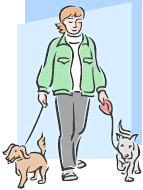
With today’s hectic schedules, it is sometimes hard to keep on top
of all of the responsibilities of the job and family, including the dog. Many
busy families are turning to a variety of pet services. But with the pet
industry being basically unregulated, how do you know how to choose the best
person for the job?
In this and the coming issues, we will try to provide some basic guidelines to help dog owners select the right professional. In this issue, we will focus on what to look for when hiring a professional dog walker.
Here are some simple suggestions of what to look for and questions to ask that you may want to consider in selecting a professional dog walker:
Small Dogs are Real Dogs Too by Sarah Jane Cuff
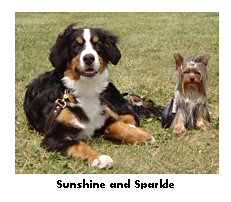
My husband and I were out one evening walking our furry four-legged
’kids’ Sparkle and Sunshine, a 3lb Yorkshire terrier and a 50 lb Bernese
mountain puppy respectively. As we turned the corner, we noticed a golden
retriever and his owner headed in our direction. Of course, Sparkle and Sunshine
both wanted to say hi so we let the pups greet each other.
As the dogs were playing together, the retriever’s owner leaned over to pat Sunshine telling her what a gorgeous dog she is. Then she glanced at Sparkle dressed in her little pink t-shirt and pink hair bow. In a tone of either disgust or disbelief she said, “And look at that lame excuse for a dog!” Unfortunately, that is not the first time I have encountered the thinking that tiny dogs are not real dogs. Having learned not to take offence when someone criticizes my little dog, I prefer to imagine how people would react if only they knew just how much of a ‘real’ dog she truly is. When she goes for walks beside me on her leash, Sparkle has the same stamina as Sunshine. Her recall is amazing. She sits when asked. And despite owning doggy pajamas, a rain coat and multiple t-shirts and sweaters (all of which aid in keeping her tiny body warm—they are not just fashion statements), Sparkle is just as eager as Sunshine to play fetch or roll in the grass.
Yes, small dogs are real dogs too. While some people have a personal preference for one size over the other, all dogs are capable of being your best friend. Even if an adverse behaviour common in dogs of a certain size is the issue, it is amazing how proper training can eliminate it. In the end, both tiny dogs and large dogs are wonderful companions who enhance our quality of life, as long as they are loved, cared for and taught good manners.
Aussie Rescue and Placement Helpline, Inc. (ARPH) by Ginnette Wilson
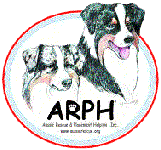 In increasing numbers, people are falling in love with the
Australian Shepherd breed. The versatile, athletic and intelligent "Aussie",
with its beautiful array of coat colours, intensely loyal nature and enormous
grin, is showing up regularly in everything from the movies and advertisements,
to herding and agility competitions. But popularity comes with a price - many
owners find their new Aussie too energetic, that beautiful coat sheds, and why
is he barking when alone in the yard? For any number of reasons, and through no
fault of their own, more and more Aussies are finding themselves
homeless.
In increasing numbers, people are falling in love with the
Australian Shepherd breed. The versatile, athletic and intelligent "Aussie",
with its beautiful array of coat colours, intensely loyal nature and enormous
grin, is showing up regularly in everything from the movies and advertisements,
to herding and agility competitions. But popularity comes with a price - many
owners find their new Aussie too energetic, that beautiful coat sheds, and why
is he barking when alone in the yard? For any number of reasons, and through no
fault of their own, more and more Aussies are finding themselves
homeless.
ARPH, the official rescue
organization of the Australian Shepherd Club of America (ASCA), is dedicated to
a happy ending for every Aussie. Active throughout Canada and the U.S., ARPH
volunteers offer a fresh start for orphaned Aussies, as well as a support
network for owners. ARPH has matched hundreds of homeless Aussies with
appropriate homes, many of them right here in Ottawa. ARPH representatives,
foster homes, and volunteers are accepted only after a thorough background
check. Each receives instruction in proper placement procedures and the care of
rescue dogs. 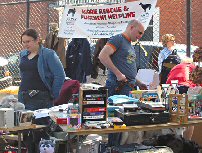 In
addition to representatives and foster homes who deal directly with the dogs,
ARPH has other volunteers who perform many varied and necessary tasks.
In
addition to representatives and foster homes who deal directly with the dogs,
ARPH has other volunteers who perform many varied and necessary tasks.
The ARPH Team is comprised of people with all sorts of experiences, from
breeders to pet owners, and each volunteer brings his or her own individual
expertise to the rescue effort.
ARPH charges an adoption fee for Aussies
they place in new homes but this is never enough to cover expenses. Ordinary vet
costs (vaccinations, spay/neuter, heartworm test and preventative, etc) often
exceed adoption fees, and the rescue never recoups the day-to-day, miscellaneous
expenses of housing foster dogs. All dogs adopted out are spayed or neutered.
ARPH's rescue efforts are also supported by donations from those who love the
breed, including donations from the Australian Shepherd Club of America and
donations received from adopting homes.
Every responsible breeder knows
that the gene that produces the stunning mottled effect, called "merle" in many
Aussies can also produce deafness and/or blindness when two merles are bred
together. Unscrupulous breeders know that a merle pup can bring a high price and
are willing to risk it to better their odds. The result can be a dog like Tilly.
At just 9 days old, pure white and stone deaf, tiny Tilly was dumped in a
parking lot. Luckily, she was found and, for four weeks, was fostered by an
employee of the Bayview Veterinary Hospital. Brought into the ARPH program, a
volunteer with a deaf Aussie of her own became Tilly's new foster mom. For the
next two months, she nursed her through a serious illness, taught her hand
signals, and brought her to work every day. Tilly clearly didn't know or care
that she was supposed to be "different". She developed an outgoing,
happy-go-lucky personality, and quickly gained a serious fan club. The day Tilly
went to her forever home was one of great joy, but also sadness, for all those
she left behind.
There are many stories like Tilly's, and many more
wonderful dogs waiting for their forever homes. If you are interested in
learning more about the Australian Shepherd, considering fostering or adopting a
rescued Aussie or interested in exploring other ways you can help, please visit
ARPH Ontario's website at http://www.ontarioaussies.ca/ or contact one of our Ontario
representatives: in Southern Ontario, Niki at [email protected] and in Central Ontario, Nicole at
[email protected].
As the warmer weather approaches,
more and more people will be taking to the outdoors to walk their dogs. In
multi-use parks and trails, certain activities do not blend easily and extra
effort is needed to ensure that the possibility of problems and conflict are
minimized.
Dog walking is a privilege. Please help to maintain and
expand access to public parks and trails by following a few simple
rules.

Obey the regulations regarding on-leash and off-leash areas (even if you don't agree with them). 
Have your dog(s) under control at all times - dogs that do not respond to voice commands or hand signals should not be allowed off leash. 
Always leash your dog(s) in parking lots. Loose dogs in parking lots are at risk. 
Always pick up after your dog(s). If you cannot find where your dog(s) pooped, then ease your conscience by picking up another dog's offering. 
Remember the 5-second rule. Chat with friends but makes sure your eyes connect with your dog every five seconds. That way, you will notice if they misbehave or poop. 
Please, please, please do not hang poop bags on trees or leave them on the ground; even if you plan to collect them up on your way back, you may forget or take a different route. Left-over poop bags are unsightly, unhygienic and are a constant source of complaints. 
Please do not allow your dog(s) to dig holes. They pose a safety hazard for walkers and dogs. 
Respect the rights of all park users - dog walkers and others. Do not let your dog(s) behave inappropriately towards people and other dogs. Be especially careful if there are children, joggers or cyclists around.
Proposal to Explore the Feasibility of Composting Dog Waste in Public Parks
Prepared by: Lyn Taylor, Director, National Capital Coalition for People and Dogs
September 16, 2004
Project Purpose
The purpose of this proposal is to explore the possibility of finding a more user and environmentally-friendly alternative to deal with the issue of pet waste disposal. It proposes a solution which the National Capital Coalition for People and Dogs believes is:
Project Objective
The objectives are as follows:
![]() email RDOC
email RDOC